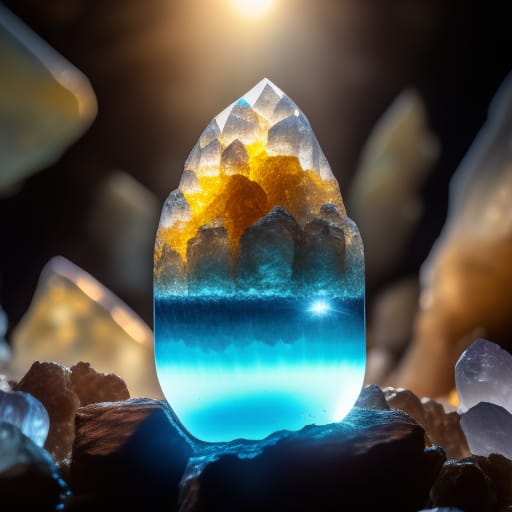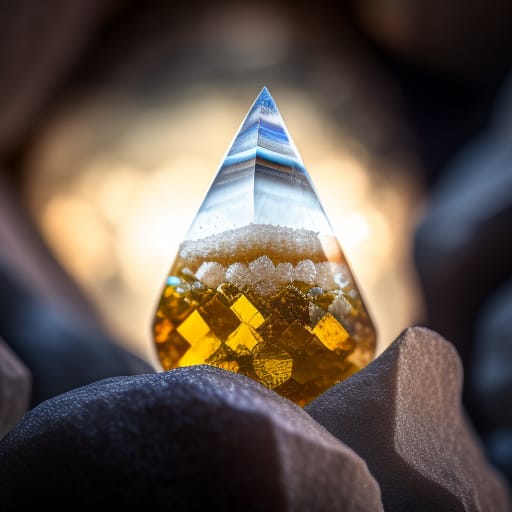Crystal structures are the intricate and orderly arrangements of atoms within a crystal. Understanding crystal structures is key to unraveling the properties of materials and exploiting them for applications. This beginner’s guide provides an overview of the fundamental concepts behind crystal structures and crystallography.

What Are Crystal Structures?
A crystal structure refers to the characteristic arrangement of atoms inside a crystalline material. It is the atomic blueprint that gives a crystal its shape and properties.
Crystals are solids that have a highly ordered internal structure made up of a repeating pattern of atoms, ions or molecules. They form symmetrical geometrical shapes with flat faces and straight edges.
The crystal structure describes:
- The unit cell – the smallest group of particles with the overall symmetry of the crystal.
- The lattice – the pattern in which the particles are arranged.
- The basis – the type of particles at each lattice point.
The study of crystal structures, called crystallography, provides key insights into a material’s properties. By understanding the atomic arrangements in crystals, scientists gain knowledge that enables technological advances.
A Brief History of Crystallography
Crystallography dates back to the 17th century when scientists first observed the geometrical shapes and faceting of crystals under magnification. They correctly deduced that the shapes must arise from regular internal structures.
Key milestones in crystallography:
- 1669 – Nicolaus Steno discovers the constancy of interfacial angles in quartz crystals, suggesting an underlying repetitive geometry.
- 1895 – Wilhelm Röntgen discovers X-rays, a tool later vital to uncovering crystal structures.
- 1912 – Max von Laue and colleagues demonstrate that X-rays can be diffracted by crystals, revealing their lattice spacing.
- 1913 – William Henry and William Lawrence Bragg explain X-ray diffraction via Bragg’s law.
- 1914 – William Henry Bragg and William Lawrence Bragg are awarded the Nobel Prize in Physics for determining crystal structures.
- 1930s – Direct methods are developed to solve crystal structures from X-ray data.
- 1953 – James Watson and Francis Crick uncover the double helix structure of DNA using X-ray diffraction data collected by Rosalind Franklin.
Atomic Structure
To understand crystal structures, we must first consider the structure of individual atoms.
Atoms are the fundamental building blocks of matter consisting of a dense nucleus surrounded by a cloud of electrons.
The nuclei contain positively charged protons and electrically neutral neutrons, while the orbiting electrons are negatively charged.
Atomic Models
Over the years, scientists developed atomic models to explain experimental observations:
- Plum pudding model (Thomson 1904) – atoms are spheres of positive charge with embedded electrons
- Rutherford model (1911) – atoms have a tiny dense nucleus orbited by electrons
- Bohr model (1913) – electrons occupy quantized orbitals around the nucleus
- Quantum mechanical model – uses quantum mechanics to describe the probability clouds for the position of electrons
Electron Configuration
The electron configuration describes the distribution of electrons in shells and subshells around the nucleus. This governs the chemical properties of elements.
The periodic table arranges the elements based on their atomic number or number of protons. It groups elements with similar electron configurations into columns called groups.
Chemical Bonding
Atoms bond together to form molecules and crystal structures. The outer electrons called valence electrons are involved in bonding.
- Ionic – Transfer of electrons to form charged ions that attract electrostatically
- Covalent – Sharing of electrons between atoms
- Metallic – Sea of delocalized electrons surrounded by positively charged metal ions
Crystal Lattice
The crystal lattice describes the repeating three-dimensional pattern in which particles are arranged in a crystal. Understanding the lattice is key to solving crystal structures.
Types of Crystal Lattices
There are 14 possible distinct three-dimensional lattices called Bravais lattices. They belong to 7 crystal systems based on their symmetry.
Cubic
- Simple cubic
- Body-centered cubic
- Face-centered cubic
Tetragonal
- Simple tetragonal
- Body-centered tetragonal
Orthorhombic
- Simple orthorhombic
- Body-centered orthorhombic
- Face-centered orthorhombic
- Base-centered orthorhombic
Rhombohedral
- Simple rhombohedral
Hexagonal
- Simple hexagonal
- Hexagonal close-packed
Monoclinic
- Simple monoclinic
- Base-centered monoclinic
Triclinic
- Simple triclinic
Unit Cell
The unit cell is the smallest repeating unit with the full symmetry of the lattice. It is defined by three axial lengths (a, b, c) and interaxial angles.
When stacked in three dimensions, the unit cells fill all space without gaps or overlaps, forming the crystal lattice.
Unit cells can be primitive containing only lattice points at the corners or non-primitive with additional lattice points on faces, edges or body centers.

X-ray Diffraction and Bragg’s Law
X-ray diffraction is an invaluable tool for determining unknown crystal structures.
When X-rays strike a crystal, they are diffracted by the electron clouds of the atoms in the crystal lattice. This produces a diffraction pattern that encodes the crystal structure.
Bragg’s Law
English physicists Sir William Henry Bragg and his son Sir William Lawrence Bragg explained X-ray diffraction using Bragg’s law in 1913, winning them the 1915 Nobel Prize in Physics.
Bragg’s law gives the condition for diffraction peaks from crystal planes with spacing d:
$$n\lambda = 2d\sin\theta$$
- $n$ – An integer
- $\lambda$ – Wavelength of the X-ray beam
- $d$ – Distance between crystal planes
- $\theta$ – Angle of diffraction
By measuring the diffraction angles and intensities, the crystal lattice can be uncovered.
Miller Indices
Crystal planes and directions are denoted using Miller indices written as (hkl).
Miller indices are reciprocals of the points where the planes intersect the crystal axes in terms of fractions of the unit cell dimensions.
Crystal Symmetry
The characteristic symmetry of crystals intrinsically links to their underlying atomic structure and lattice geometry. Capturing the symmetry is key to solving crystal structures.
Symmetry elements include:
- Rotational axes of symmetry
- Mirror planes
- Inversion centers through which the crystal is symmetrical
- Rotation-reflection axes
Point Groups
Point groups indicate the combination of symmetry operations that leave one point fixed in the crystal lattice.
The 32 possible crystallographic point groups belong to one of the 7 crystal systems:
Triclinic – 2 point groups Monoclinic – 2 point groups Orthorhombic – 4 point groups Tetragonal – 7 point groups Trigonal – 7 point groups Hexagonal – 7 point groups
Cubic – 5-point groups
Space Groups
Space groups show all the symmetry operations compatible with the crystal lattice, including translations that shift the lattice.
There are 230 possible space groups describing all combinations of symmetry operations and translations that can occur in three dimensions.
Determining the space group is key to solving the entire crystal structure.
Crystal Defects
Crystal defects are disruptions in the ideal repeating pattern of the crystal lattice. Understanding defects helps improve the material’s properties.
Types of Defects
- Point defects – Missing or extra ions or atoms substituting ions in the lattice
- Line defects – Row of disrupted ions as in edge dislocations
- Surface defects – Irregularities at the crystal surface
- Volume defects – Voids within the bulk crystal
Point defects are the most common. Adding impurity atoms intentionally introduces doping defects to alter electrical and optical properties.
Crystal Growth
Crystal growth is the process of forming an orderly crystal lattice starting from building blocks like atoms, ions or molecules. Controlled growth allows the creation of large single crystals for applications.
Stages of Crystal Growth
Crystal growth happens in two main stages:
- Nucleation – Isolated groupings of particles form small ordered clusters acting as seeds
- Growth – Layers are added to the seeds in an ordered way to grow the crystal
Crystal Growth Mechanisms
- Supersaturation – A driving force for growth arising from higher than equilibrium concentration or temperature
- Surface energy – Tendency of particles to adopt positions that minimize surface area and energy
- Attachment kinetics – How particles attach at growth sites depending on bonds and diffusion
Crystal Growth Methods
- Melt techniques – Slowly lowering the temperature to crystallize from a melt
- Solution techniques – Allowing crystallization as the solvent evaporates
- Vapor deposition – Depositing atoms or molecules from a vapor onto a seed
Crystal Morphology
Crystal morphology describes the characteristic external shape defined by the crystal’s faces, edges and corners. It results from the lattice structure and relative growth rates in different directions.
Specific crystallographic planes grow slowly, surviving as flat faces. Rapidly growing directions form edges and corners.
Crystallographic Planes
Crystallographic planes indicate possible flat cleaving surfaces through the crystal lattice. Their orientations are defined using Miller indices (hkl).
Some examples:
- (001) – perpendicular to the [001] axis
- (110) – intersects the x-axis at a and the y-axis at b
- (111) – equally inclined to all three axes for cubic crystals
Zone Axis
The zone axis is the direction normal to a set of parallel planes with different (hkl) indices. It reveals possible viewing directions to observe the crystal planes edge on.
Crystallographic Directions
Crystal directions are lines linking points in the lattice passing through the origin. They are also defined by Miller indices [hkl].
For example:
- [001] – parallel to the c-axis
- [110] – in the (110) plane
- [111] – along the body diagonal of a cubic unit cell
Crystallographic Axes
The orientation of the crystal is described relative to the crystallographic axes a, b, and c. These correspond to the edges of the unit cell.
Different crystal systems have conventions for axis lengths and angles between them. For example:
- Cubic – a=b=c and α=β=γ=90°
- Tetragonal – a=b≠c and α=β=γ=90°
- Orthorhombic – a≠b≠c and α=β=γ=90°
- Hexagonal – a=b≠c and α=β=90°, γ=120°
Crystallographic Point Groups
Crystallographic point groups indicate the combination of rotational symmetry operations around a point. They are key to determining space groups.
Point groups belong to one of seven crystal systems:
Triclinic – 2 (no rotational symmetry)
Monoclinic – 2 (twofold rotational axis)
Orthorhombic – 4 (three mutually perpendicular twofold axes)
Tetragonal – 7 (one fourfold axis)
Trigonal – 7 (one threefold axis)
Hexagonal – 7 (one sixfold axis)
Cubic – 5 (four threefold axes)
Crystallographic Space Groups
Space groups describe the full symmetry of the crystal including rotational operations and translations generating the lattice.
The 32 point groups combine with 14 Bravais lattices to give 230 three-dimensional space groups.
Space groups are described using:
- Hermann-Mauguin notation – E.g. Pnma, P43m
- International notation – E.g. 62, 215
Determining the space group is essential to solving crystal structures.
Crystallographic Databases
Crystallographic databases store atomic coordinates and metadata for published crystal structures. They enable data sharing and reuse.
Major databases:
- Cambridge Structural Database – Over 1 million small molecule structures
- Protein Data Bank – >170,000 protein structures
- Inorganic Crystal Structure Database – >200,000 inorganic and mineral structures
Uses:
- Look up known crystal structures
- Identify structural relationships
- Discover new structure-property trends
- Develop computational methods

Crystallographic Software
Specialized software aids crystal structure determination and analysis:
Structure solution
- SOLVE/RESOLVE – Uses direct methods algorithms
- SHELX – For small molecules using heavy atoms
- PHENIX – For macromolecular structures like proteins
Refinement and analysis
- SHELXL – Small molecule refinement
- REFMAC – Macromolecular refinement
- Coot – Model building and validation
- VESTA – 3D crystal structure visualization
- MERCURY – Crystal structure visualization and analysis
- Materials Studio – Modeling and simulation
In summary, understanding crystal structures requires grasping concepts of atomic structure, lattice geometry, symmetry, and growth. With foundations in crystallography, researchers can predict properties from structures and rationally design new crystalline materials. Crystallographic techniques, software tools, and databases provide invaluable resources to unlock the microscopic world of crystals.
Conclusion
Crystal structures arrange atoms or molecules in highly ordered repeating patterns crucial to a crystal’s macroscopic physical properties. X-ray diffraction enables the determination of these microscopic arrangements. Concepts like the crystal lattice, unit cell, point groups, and space groups categorize the symmetry. Growth mechanisms control the formation of large crystals. Databases and software facilitate analyzing and solving crystal structures. An understanding of these fundamental crystallographic principles forms the basis for unraveling the structure-property relationships in crystalline materials. This enables designing materials like semiconductors, superconductors, and pharmaceuticals critical to technological advancement.
Resources to Learn More
- International Union of Crystallography https://www.iucr.org/
- Databases – Cambridge Crystallographic Data Centre https://www.ccdc.cam.ac.uk/
- Software – Rigaku Oxford Diffraction https://www.rigaku.com/en/products/smc/crystallographic-software
- Books – Linden, David. Handbook of Crystallography. Wiley Blackwell, 2010.
- Journals – Crystal Growth and Design – https://pubs.acs.org/journal/cgdefu
Frequently Asked Questions
What are the main techniques used to determine crystal structures?
The two most important techniques are X-ray diffraction and neutron diffraction. When X-rays interact with the orderly crystal lattice, they produce diffraction patterns that can be analyzed using Bragg’s law to uncover the atomic arrangements and symmetry elements. Neutron diffraction is also valuable for locating light atoms like hydrogen in a structure.
How are crystallographic directions and planes defined?
Crystallographic directions and planes are defined using a notation called Miller indices. The Miller indices consist of three numbers hkl in parentheses that denote the reciprocals of the fraction of the unit cell axes intersected by the plane or direction. Miller indices identify possible flat crystal faces and cleaving directions.
What information is contained in a crystallographic database?
Crystallographic databases contain the full three-dimensional atomic coordinates and metadata for crystal structures that have been experimentally determined and published. The atomic coordinates provide the detailed crystal lattice arrangements while metadata includes information like the chemical formula, space group, structure authors, and journal citation.
What is the role of symmetry in crystal structures?
Symmetry is intrinsically linked to the orderly repetitive nature of ideal crystal structures. Characteristic symmetry elements occur in the atomic arrangements that repeat in systematic ways to fill space. The combination of rotational axes and mirror planes is summarized by the crystallographic point groups and space groups which are key to solving crystal structures.
How does the unit cell relate to the crystal lattice?
The unit cell is the smallest repeating unit containing the full symmetry of the crystal lattice. When translated in three dimensions, the unit cell fills all space to build up the overall crystal lattice without gaps or overlaps. So knowing the unit cell provides the blueprint for the entire infinite periodic lattice.